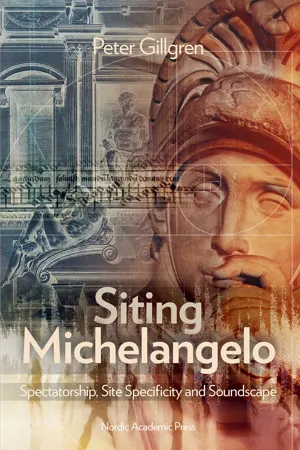
- 240 pages
- English
- ePUB (mobile friendly)
- Available on iOS & Android
About this book
Michelangelo's originality as an artist lay not only in ideas about perfection and beauty, but also in his unique approach to the artistic process and art's site specificity. Michelangelo's frescoes in the Sistine Chapel and the sculptures of the Medici chapel and Julius II's tomb should all be understood as dramatic interventions at their sites. Instead of adapting to and blending in with their surroundings, these are works that interact with the space, the ceremonies, and the music. In addition, the many uncompleted works and the artist's own writings point to an aesthetic of continuous processing, where the fundamentals remain as important as the finished work. In Siting Michelangelo, Peter Gillgren investigates Michelangelo's works as conceived with the aim of altering and rearranging what was already in place. Gillgren's study shows that not only must we look closely at works of art, but we must fully consider them as embodiments of their sitedness. This original and thought-provoking book applies a fresh critical perspective to the essentials of the discipline of art history.
Frequently asked questions
- Essential is ideal for learners and professionals who enjoy exploring a wide range of subjects. Access the Essential Library with 800,000+ trusted titles and best-sellers across business, personal growth, and the humanities. Includes unlimited reading time and Standard Read Aloud voice.
- Complete: Perfect for advanced learners and researchers needing full, unrestricted access. Unlock 1.4M+ books across hundreds of subjects, including academic and specialized titles. The Complete Plan also includes advanced features like Premium Read Aloud and Research Assistant.
Please note we cannot support devices running on iOS 13 and Android 7 or earlier. Learn more about using the app.
Information
Table of contents
- Cover
- Title
- Copyright
- Contents
- Preface
- 1. The Wennerberg experience
- 2. Practices and theories of siting
- 3. Early works
- 4. The Pietà in Rome
- 5. The Sistine Chapel ceiling
- 6. Portraits of the artist
- 7. The Medici Chapel
- 8. The tomb of Pope Julius II
- 9. The nature of sculpture
- 10. The cave of Vulcan
- 11. David
- 12. Via negativa
- 13. The late pietàs
- 14. Visible and non-visible bodies
- 15. The Last Judgement
- 16. Sistine Chapel installations
- 17. Coda
- Notes
- Appendix
- Illustrations
- References